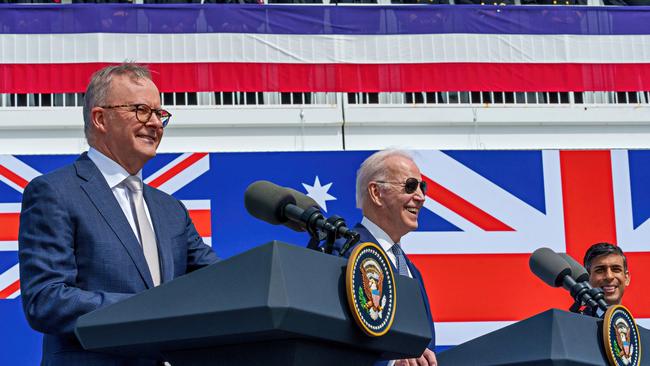
This decision is driven by deep instincts of Australian identity and strategic belief. Labor under the judgment of Anthony Albanese and the determination of Defence Minister Richard Marles has become a party of conviction in AUKUS. Labor is always a party of beliefs and AUKUS is the new belief.
Labor’s decisions will shape Australia’s future for several decades. They involve a fusion of three beliefs – the leap to a more sophisticated technological and industrial base and workforce; the conclusion that China has embarked on a quest for regional dominance that is an unprecedented risk to our national interest; and the view that our future lies in interoperable strategic deterrence with our historical allies at distance from our shores.
The AUKUS announcement on Tuesday is of global import. The surprise aspect – the stroke of genius if it works – is the US agreement that Australia can buy three US Virginia-class nuclear-powered submarines from the early 2030s, and five if required, thereby giving this country a far-earlier submarine capability than expected.
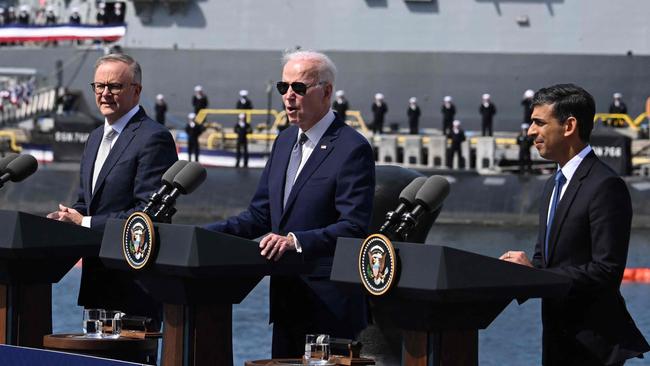
This reveals astonishing trust and strategic belief among the three AUKUS partners and remarkable US confidence in Australia. This is what China has wrought. Does it comprehend this? For Australia, there are two challenges. Can we deliver on the confidence the US is investing in us by buying and running the Virginia-class boats? And can we deliver on the construction task to work with the UK and the US in building the British-designed new nuclear-powered submarine that will be jointly produced in Britain and in Adelaide?
This agreement takes Australia into another league as a strategic power and sees a far deeper concept of alliances and partnership underpinned by shared technology.
The announcements on Tuesday are layered with audacity and risk. They cannot be delivered without core changes in the mindset of our defence industry, our navy, our technological and skills base, a lift in our economic performance and better whole-of-nation mobilisation for the task. Labor will be severely tested and it will need to change its thinking to meet the non-negotiable demands of the US nuclear submarine industry. If we don’t meet them, the project falters.
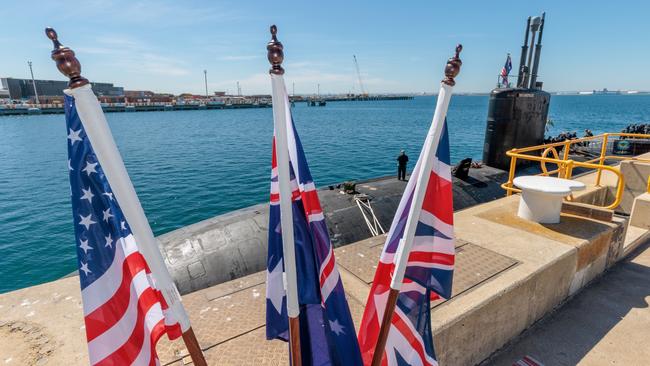
This is not just the single biggest defence step in our history. It is, as the Prime Minister said, a “transformative moment for our nation”. By this decision Australia chooses its future as a nuclear-powered submarine country tied to the military prowess of the US and Britain in a strategy of deterrence against China.
Albanese and Marles were specific, saying the capability will make Australia and its partners “better able to deter conflict”. This is an exacting, open-ended and dangerous future.
For Labor, it looms as an existential issue: you can’t knock back such a unique strategic opening with our allies. “This is an investment we can’t afford not to make,” Marles said. Former Australian ambassador to the US Joe Hockey used similar language. Here is the government’s “bottom line” response to the question of costs: sure, AUKUS costs, but we can’t allow cost to qualify the project.
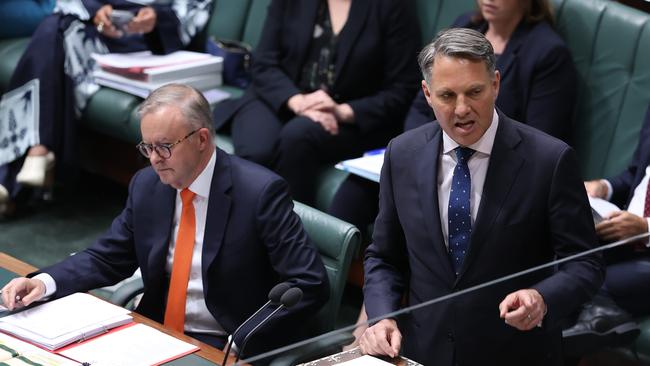
Outside critics have continually underestimated the strategic conclusion successive governments, Coalition and Labor, have reached from Beijing’s activities and intentions. It is the threat that has delivered bipartisanship.
When the Biden administration assessed AUKUS in 2021 it wanted a whole-of-nation bipartisan commitment. That was promised at the time and is delivered now. Opposition Leader Peter Dutton, closely involved with AUKUS as former defence minister, offered his full support on Tuesday. That is no surprise.
AUKUS was Scott Morrison’s vision. On Tuesday Morrison welcomed the announcement and said it was “appropriately ambitious” with his original aspiration. It was Morrison who tested the idea, embraced it, gambled that China’s assertion might bring Britain and the US on board and was vindicated.
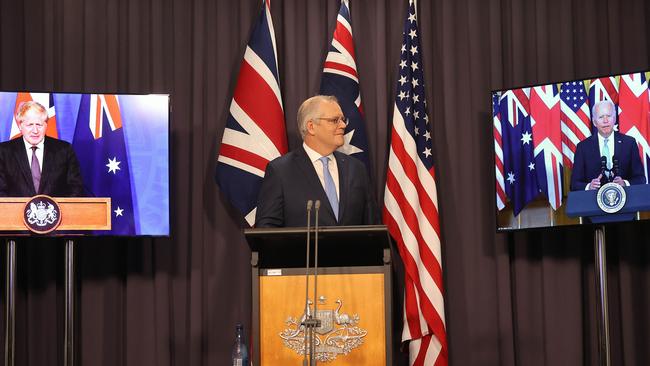
Albanese and Marles now become its builders and managers. The foundations look secure because both sides of politics have an ownership claim, as with the ANZUS Treaty. The critics will need to rail against Albanese and Marles, not Morrison.
Indeed, AUKUS is probably safer because last year’s change of government has invested Labor with its management task and beating off the opponents.
Labor is soaking the politics of this announcement. Albanese wants to make AUKUS into a vote winner. His statement was about industry and jobs, not strategy. The program will create about 20,000 jobs across the next 30 years. At its peak 4000 new workers will be employed in South Australia; Western Australia will see an additional 500 direct new jobs. Labor says this is an economic project as much as a security project.
But that half-truth conceals the bigger truth. This project is about Australia’s future defence and strategic position. Let’s not forget the real issue. We’re not building nuclear-powered warships to create jobs. They’re by-products of the epic strategic conclusions Labor has reached. AUKUS needs to be defended in terms of its strategic purpose, a point Marles recognises.
Marles casts AUKUS as an Australian response to regional provocation and the biggest military build-up in the region since World War II. He didn’t name China but he means China. His message: it would be irresponsible folly for Australia not to respond.
The real meaning of AUKUS is that security is interconnected as alliances and partnerships assume deeper integration and interoperability. This is the essence of AUKUS and its strength for the future.

The message, as Marles said, is that the security of Australia is tied to the security of the region and Australia has decided on a closer partnership with the US in this project.
Labor ministers need to get their heads around what their leaders have just done, given its central strategic argument can’t be avoided. Labor will need to sort its reply when critics allege it has just made Australia a Chinese military target.
The cleverness in the agreement is the phase-in aspect. From 2027, US and British submarines will rotate through Western Australia, after which Australia will purchase three US Virginia-class subs, the declared aim being to prevent any capability gap. This is a breakthrough decision many believed was not possible.
When do the Virginia-class arrive? “As early as the 2030s” leaves scope for slips in the timetable. Australia needs to ensure there are no slips. The new submarine being simultaneously constructed, SSN-AUKUS, means both Britain and Australia share the same boat with a US combat system. Britain will deliver its first boat in the late 2030s and the first boat from Australia will come “in the early 2040s”.
This prompts another question: can we manage with two different submarines?
Finally, defence spending will need to rise beyond 2.2 per cent of gross domestic product. Marles said the annual cost for the submarine program would work out at 0.15 per cent of GDP and called this modest.
He’s right. This figure is too modest to be real. Labor needs to beware losing credibility on the costing front.



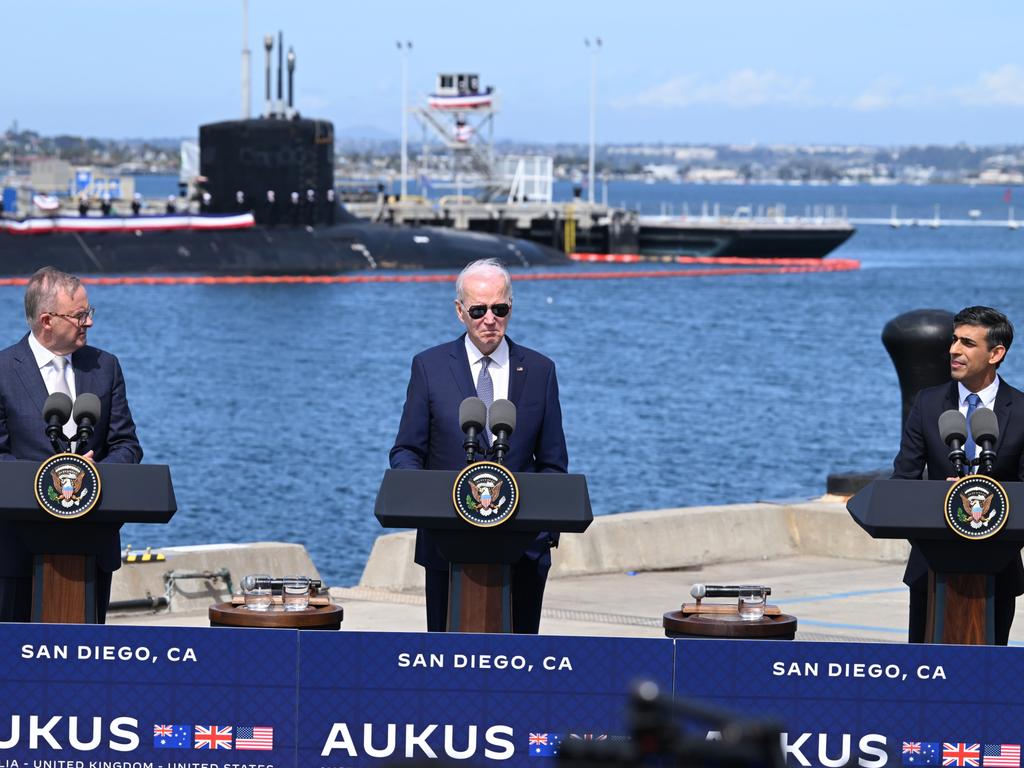
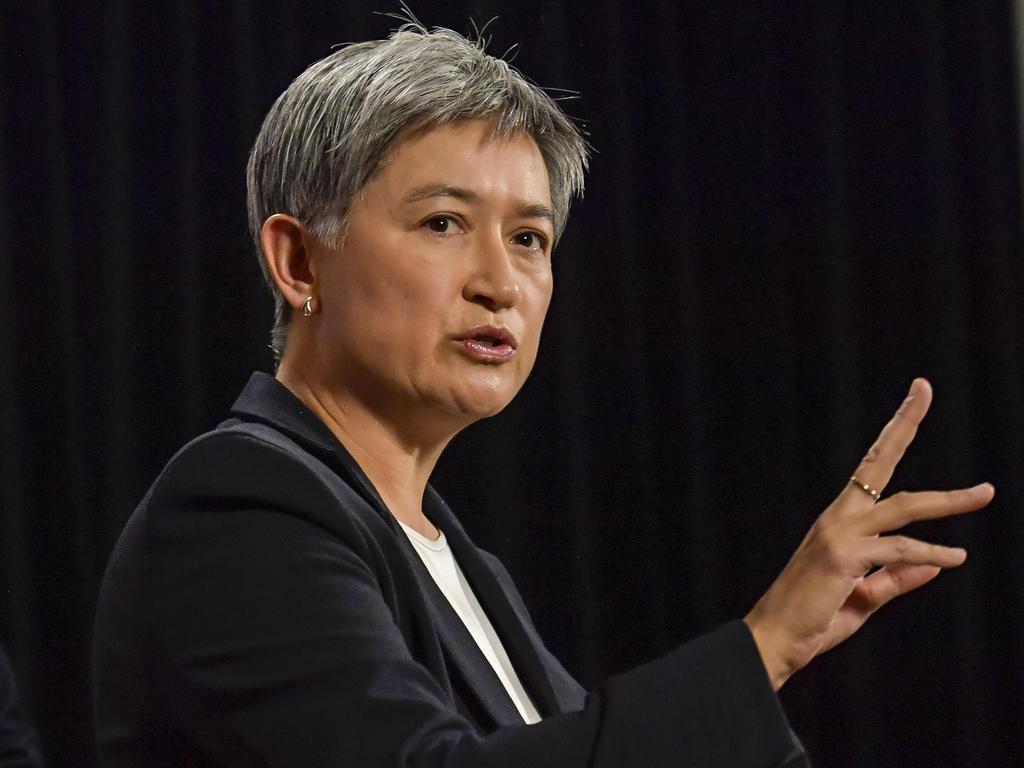
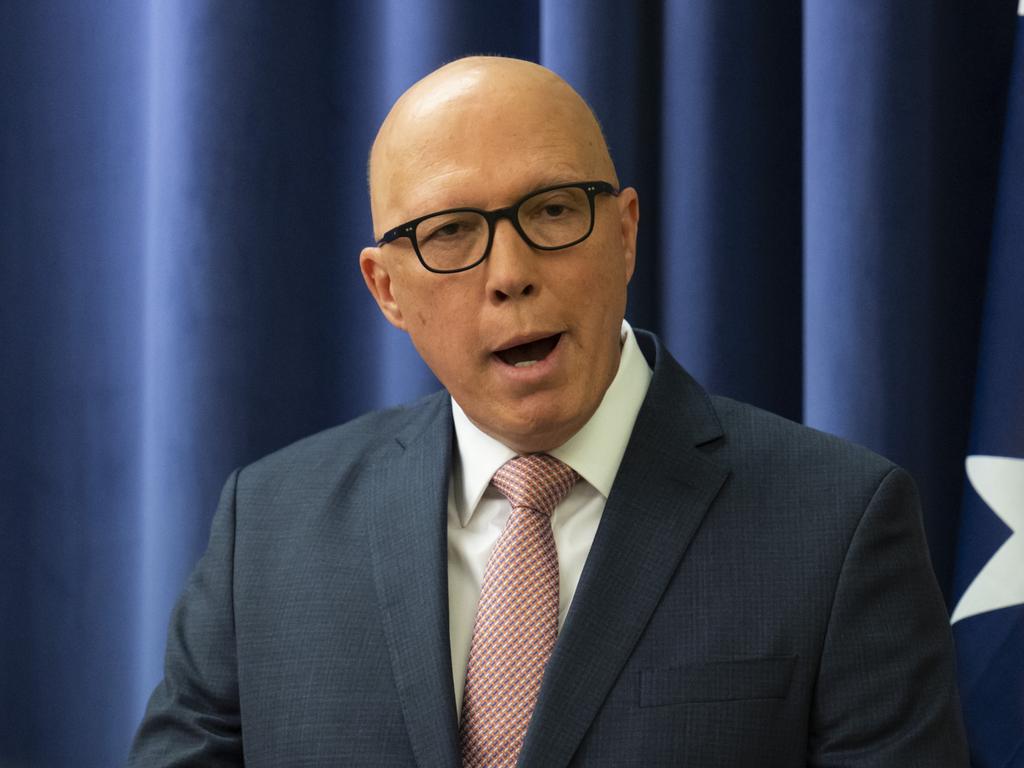
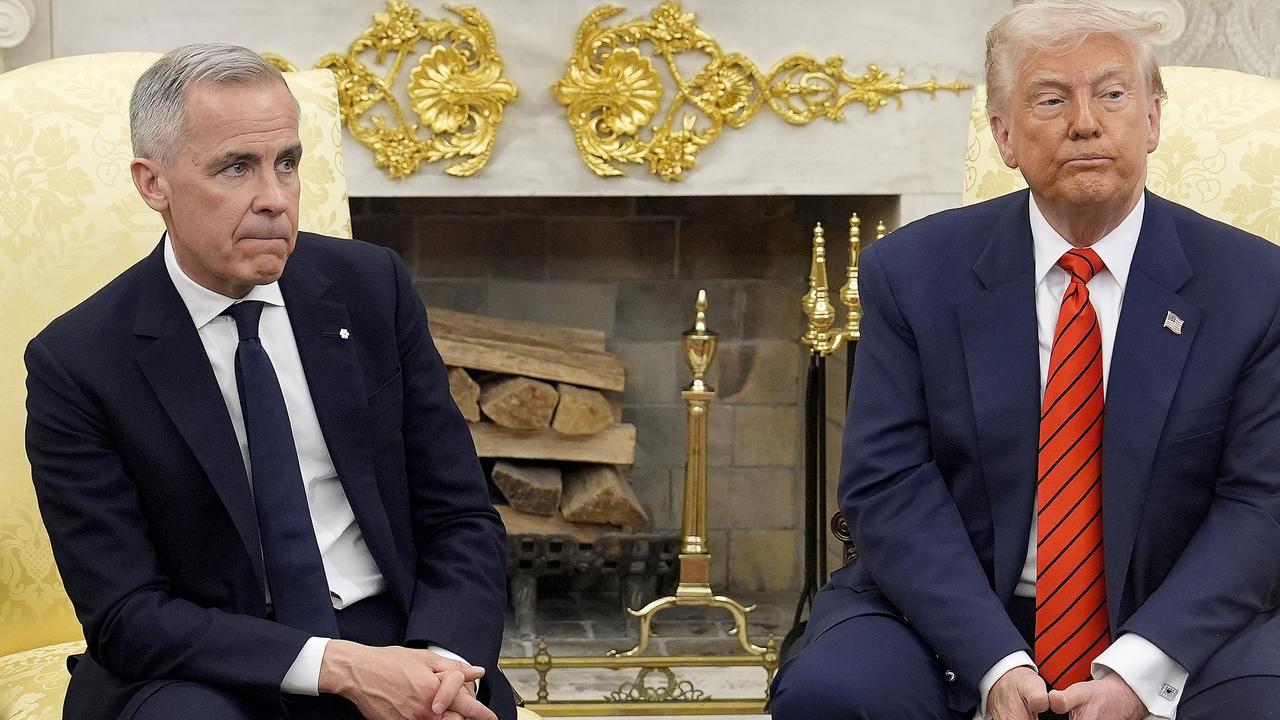

This is a revolutionary moment in the history of the Australian Labor Party. At this point Labor assumes full implementation responsibility at the national level for turning Australia into a nuclear-powered submarine nation irrevocably tied to the US and Britain in a strategy of deterrence against China’s ambitions in the Indo-Pacific.